Mechanical Properties Changes of Irradiated Thermoplastic Elastomer
Abstract
:1. Introduction
2. Materials and Methods
2.1. Material Preparation
2.2. Gel Content
2.3. Micro-Indentation
2.4. Tensile Test
2.5. Impact Tensile Test
3. Results and Discussion
3.1. Gel Content Determination
3.2. Micro-Indentation Test
3.3. Tensile Test
3.4. Tensile Impact Test
4. Conclusions
Acknowledgments
Author Contributions
Conflicts of Interest
References
- Drobny, J.G. (Ed.) Handbook of Thermoplastic Elastomers, 2nd ed.; William Andrew Publishing: Oxford, UK, 2014; ISBN 978-0-323-22136-8. [Google Scholar]
- Chattopadhyay, S.; Chaki, T.K.; Bhowmick, A.K. Structural characterization of electron-beam crosslinked thermoplastic elastomeric films from blends of polyethylene and ethylene-vinyl acetate copolymers. J. Appl. Polym. Sci. 2001, 81, 1936–1950. [Google Scholar] [CrossRef]
- Rouif, S. Radiation cross-linked polymers: Recent developments and new applications. Nucl. Instrum. Methods Phys. Res. Sect. B Beam Interact. Mater. Atoms 2005, 236, 68–72. [Google Scholar] [CrossRef]
- Ghazali, Z.; Johnson, A.; Dahlan, K. Radiation crosslinked thermoplastics natural rubber (TPNR) foams. Radiat. Phys. Chem. 1999, 55, 73–79. [Google Scholar] [CrossRef]
- Manas, D.; Ovsik, M.; Manas, M.; Stanek, M.; Stoklasek, P.; Bednarik, M.; Mizera, A. Micromechanical Properties of Thermoplastic Elastomer (TPE-E). In Advanced Materials Research; Contemporary Approaches in Material Science and Materials Processing Technologies; Trans Tech Publications: Zürich, Switzerland, 2015; Volume 1120, pp. 1198–1201. [Google Scholar]
- Murray, K.A.; Kennedy, J.E.; McEvoy, B.; Vrain, O.; Ryan, D.; Cowman, R.; Higginbotham, C.L. Effects of gamma ray and electron beam irradiation on the mechanical, thermal, structural and physicochemical properties of poly (ether-block-amide) thermoplastic elastomers. J. Mech. Behav. Biomed. Mater. 2013, 17, 252–268. [Google Scholar] [CrossRef] [PubMed]
- Steller, R.; Żuchowska, D.; Meissner, W.; Paukszta, D.; Garbarczyk, J. Crystalline structure of polypropylene in blends with thermoplastic elastomers after electron beam irradiation. Radiat. Phys. Chem. 2006, 75, 259–267. [Google Scholar] [CrossRef]
- Bocok, T.; Zicans, J.; Kalnins, M. Cross-linked thermoplastic blends of polyethylene with an elastomer 4. Thermorelaxation and adhesion characteristics. Mech. Compos. Mater. 2006, 42, 187–196. [Google Scholar] [CrossRef]
- Paran, S.M.R.; Naderi, G.; Babakhani, A. An experimental study of the effect of CNTs on the mechanical properties of CNTs/NR/EPDM nanocomposite. Polym. Compos. 2017. [Google Scholar] [CrossRef]
- Głuszewski, W.; Zagórski, Z.P.; Rajkiewicz, M. The Comparison of Radiation and a Peroxide Crosslinking of Elastomers. Raw Mater. Appl. 2015, 68, 46–49. [Google Scholar]
- Głuszewski, W.; Zagórski, Z.P.; Rajkiewicz, M. Protective effects in radiation modification of elastomers. Radiat. Phys. Chem. 2014, 105, 53–56. [Google Scholar] [CrossRef]
- Adem, E.; Angulo-Cervera, E.; González-Jiménez, A.; Valentín, J.; Marcos-Fernández, A. Effect of dose and temperature on the physical properties of an aliphatic thermoplastic polyurethane irradiated with an electron beam. Radiat. Phys. Chem. 2015, 112, 61–70. [Google Scholar] [CrossRef]
- Miroslawa, E.F.; Marta, P.H.; Judit, P.; Elizabeth, F.O. Influence of e-beam irradiation on the chemical and crystal structure of poly(aliphatic/aromatic-ester) multiblock thermoplastic elastomers. Pol. J. Chem. Technol. 2012, 14, 70–74. [Google Scholar]
- Shamekhi, M.A.; Khonakdar, H.A.; Jafari, S.H.; Damavandi, S.; Goodarzian, N.; Ghaffari, M. Electron beam cross-linking of EVA/TPU blends. Plast. Rubber Compos. 2014, 43, 202–210. [Google Scholar] [CrossRef]
- Hui, S.; Mushtaq, S.; Chaki, T.K.; Chattopadhyay, S. Effect of controlled electron beam irradiation on the rheological properties of nanosilica-filled LDPE-EVA based thermoplastic elastomer. J. Appl. Polym. Sci. 2011, 119, 2153–2166. [Google Scholar] [CrossRef]
- Mészáros, L.; Fejős, M.; Bárány, T. Mechanical properties of recycled LDPE/EVA/ground tyre rubber blends: Effects of EVA content and postirradiation. J. Appl. Polym. Sci. 2012, 125, 512–519. [Google Scholar] [CrossRef]
- Oliver, W.; Pharr, G. Measurement of hardness and elastic modulus by instrumented indentation: Advances in understanding and refinements to methodology. J. Mater. Res. 2004, 19, 3–20. [Google Scholar] [CrossRef]
- Pharr, G. Measurement of mechanical properties by ultra-low load indentation. Mater. Sci. Eng. A 1998, 253, 151–159. [Google Scholar] [CrossRef]


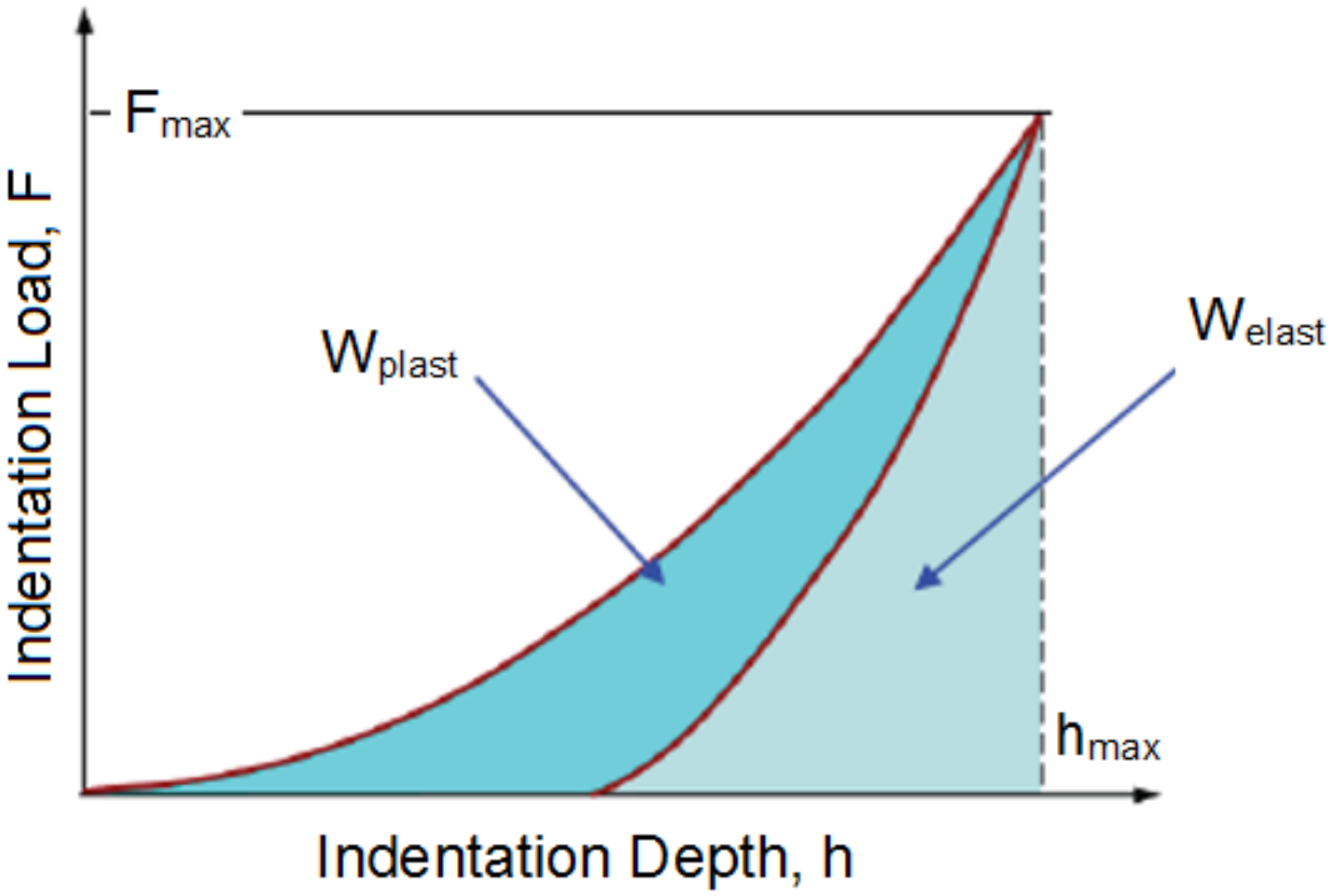
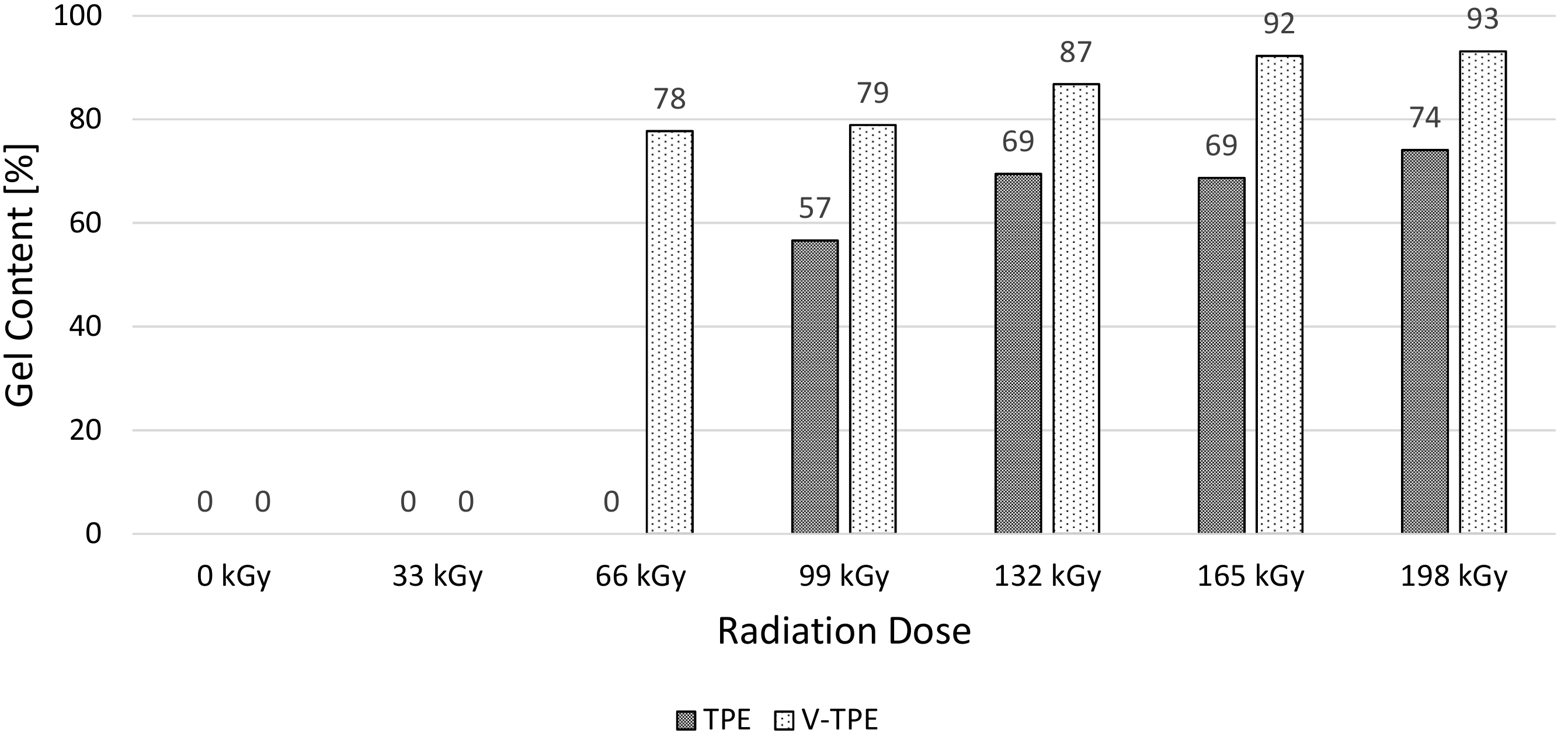
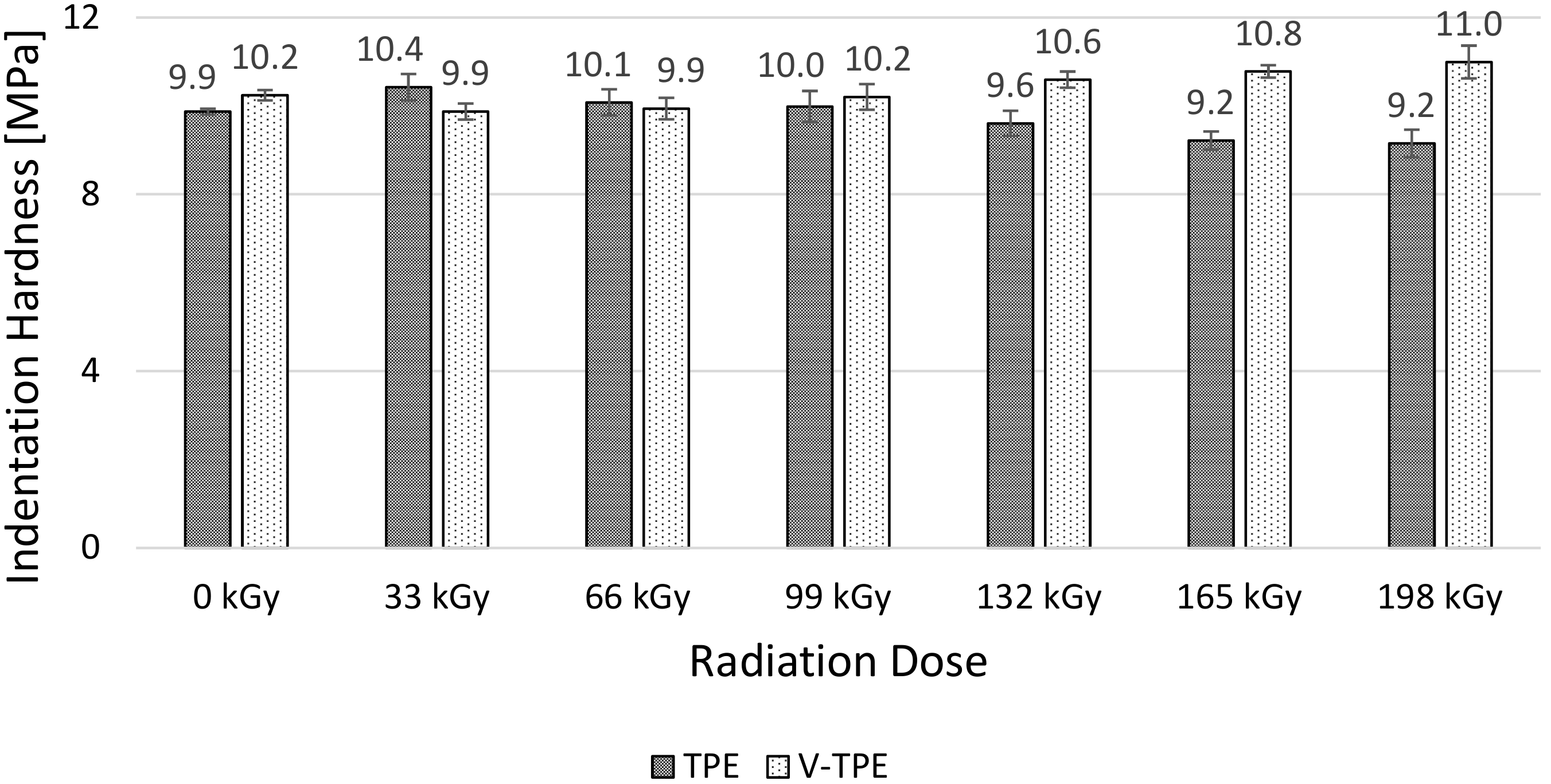
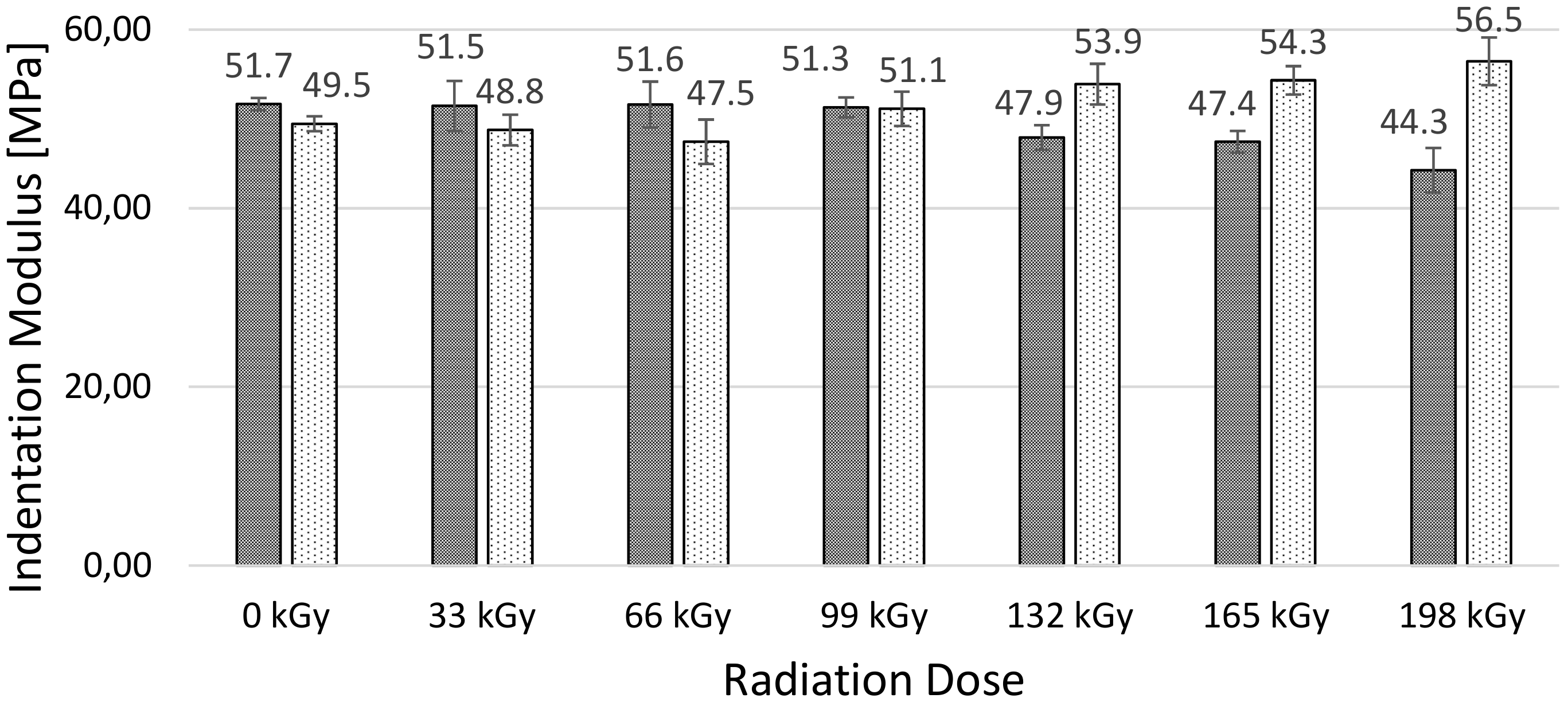
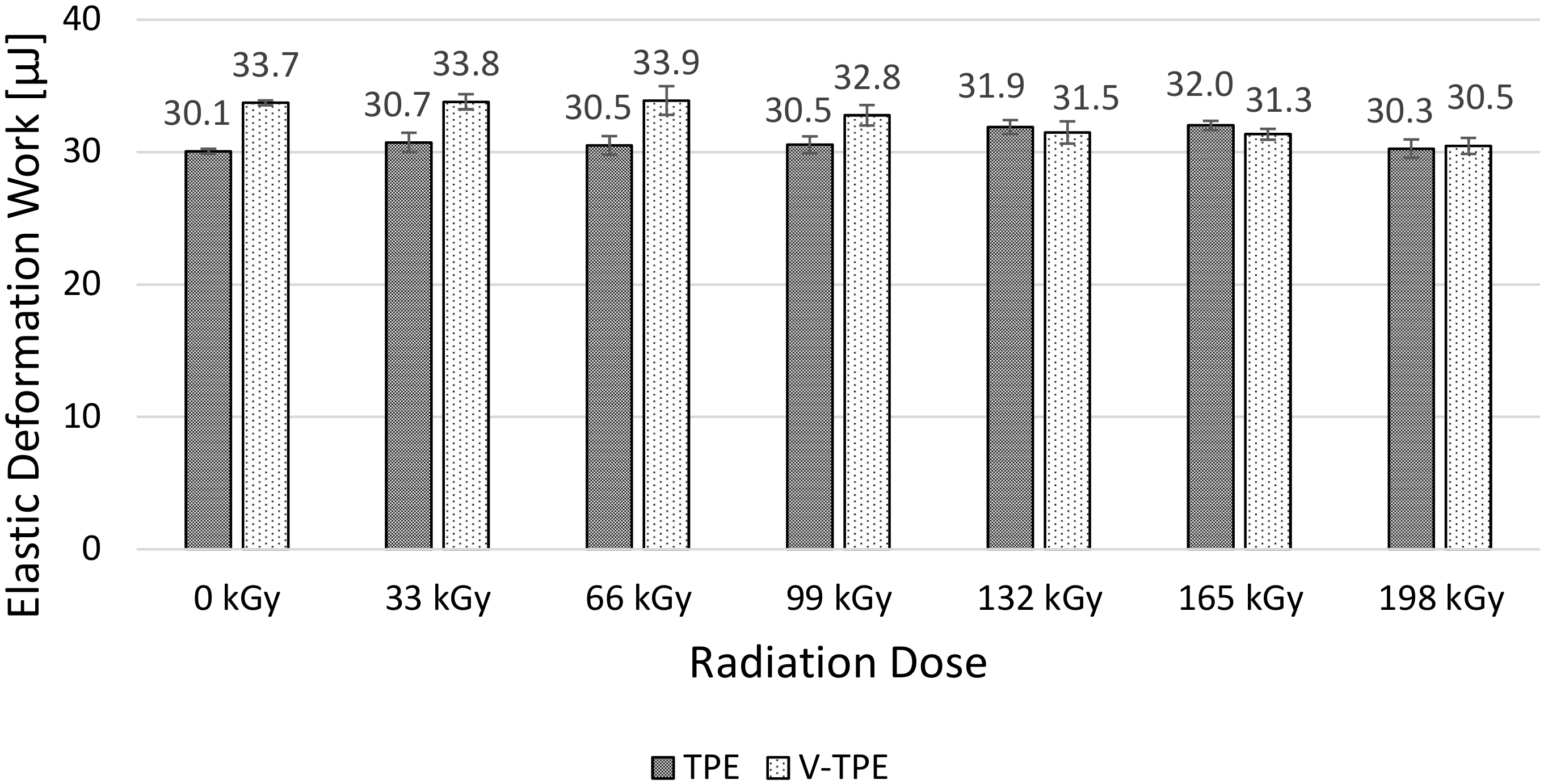
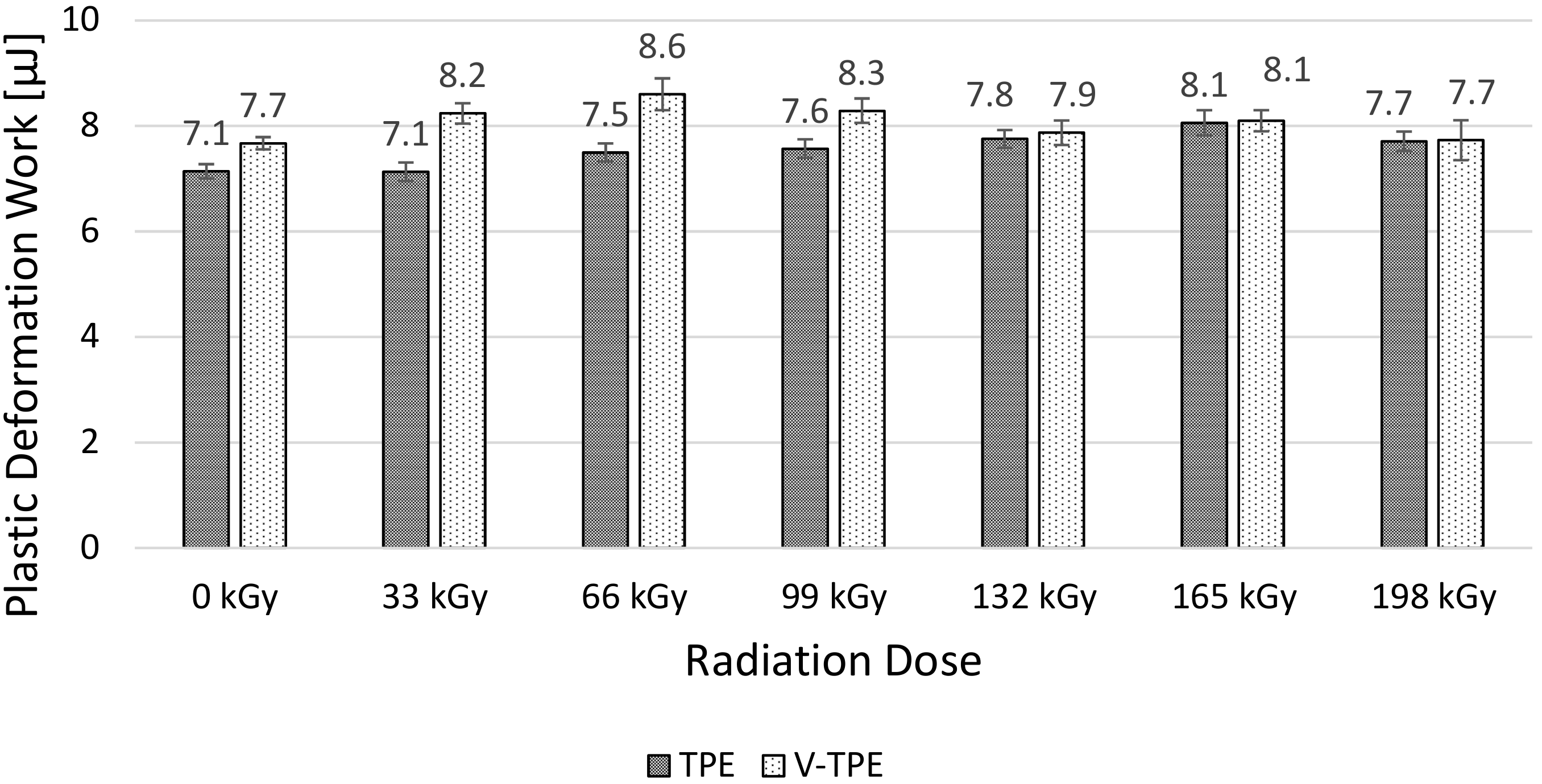
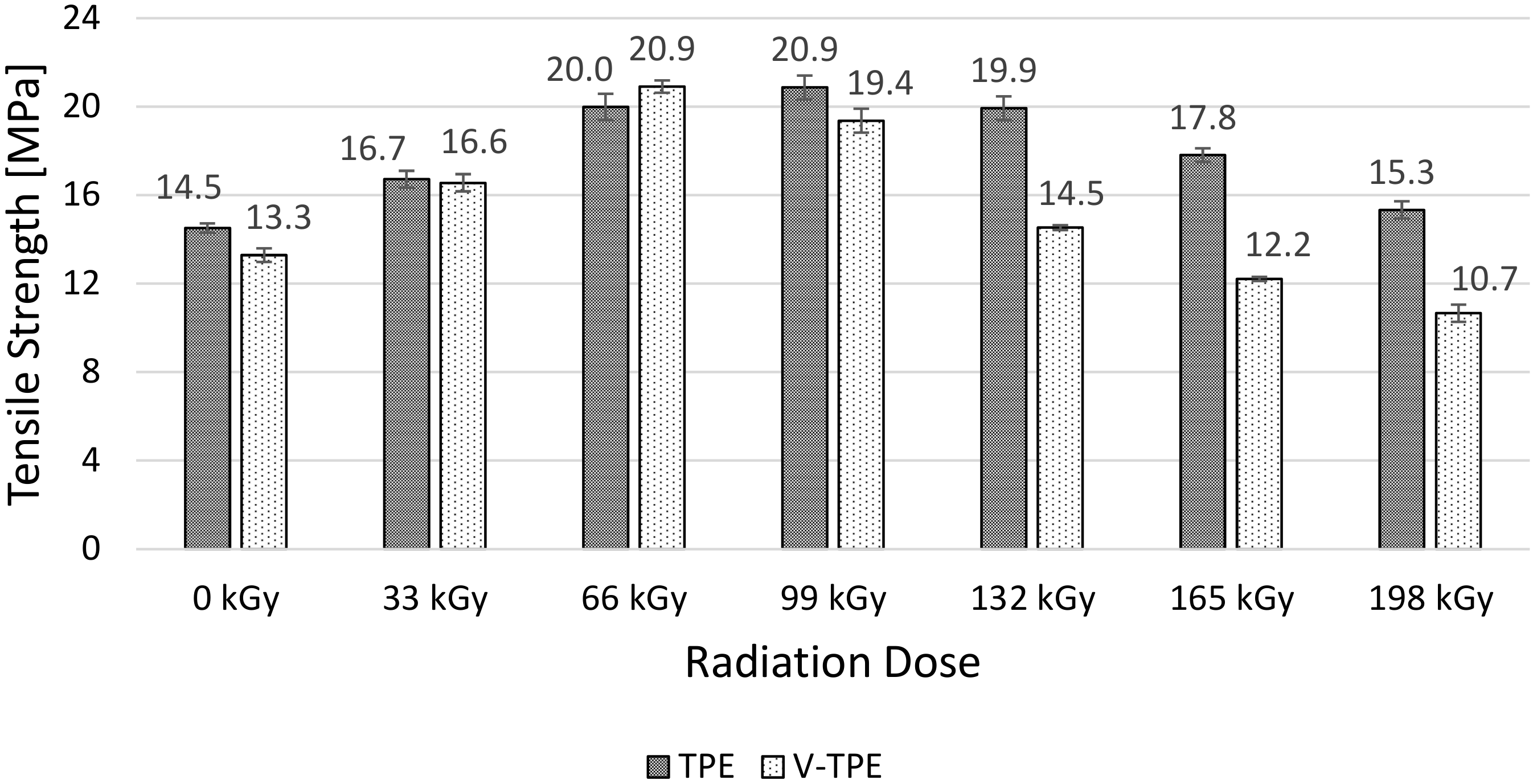
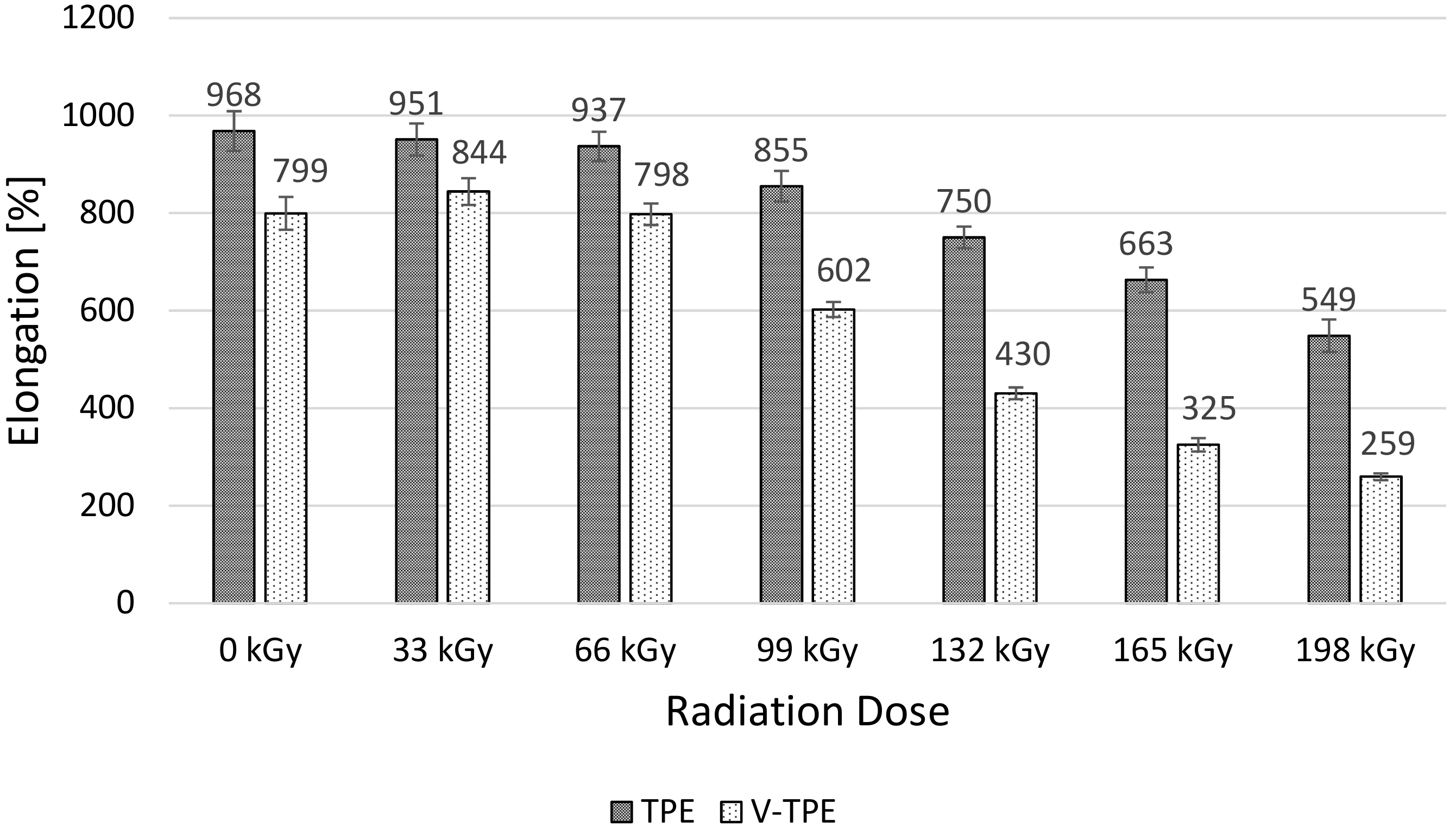
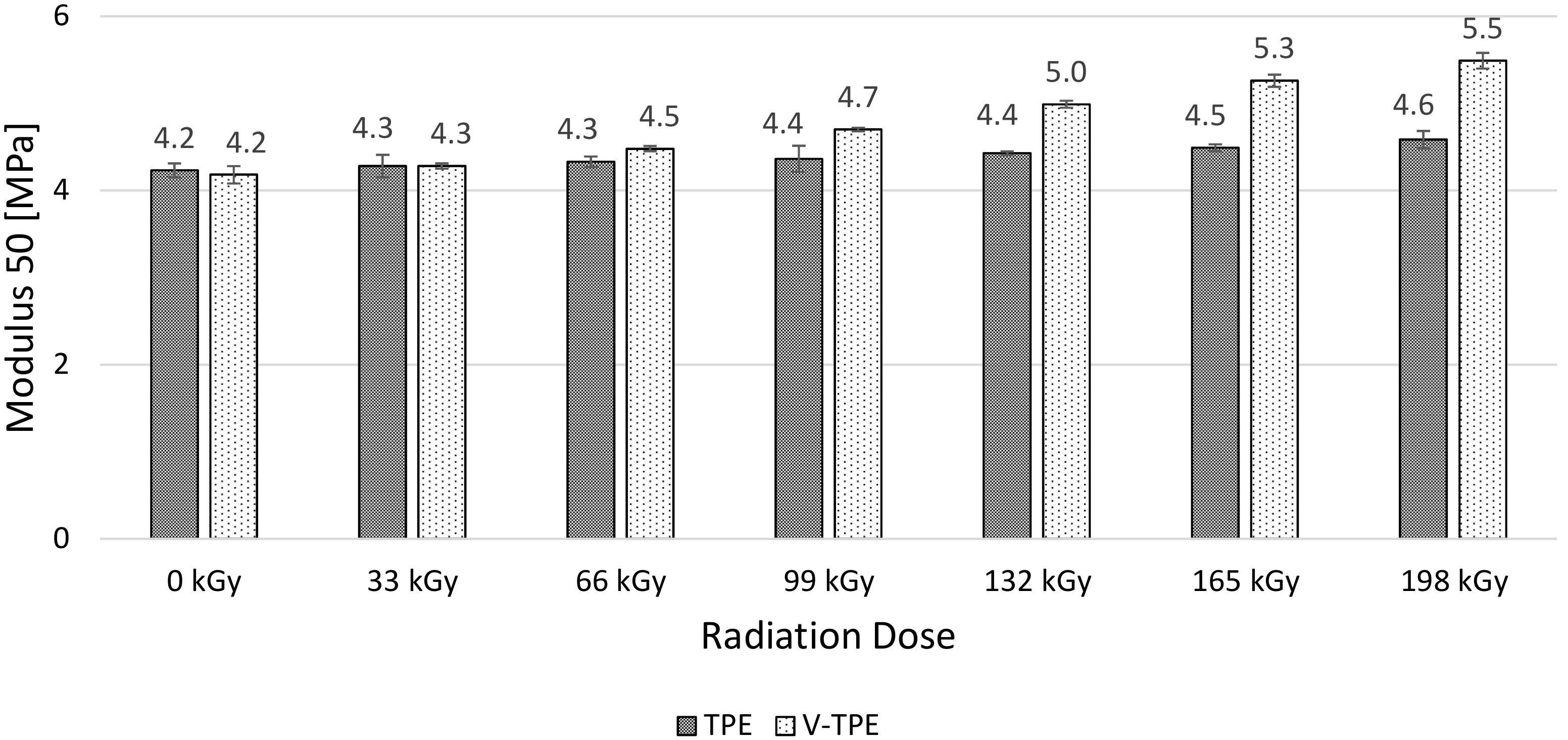
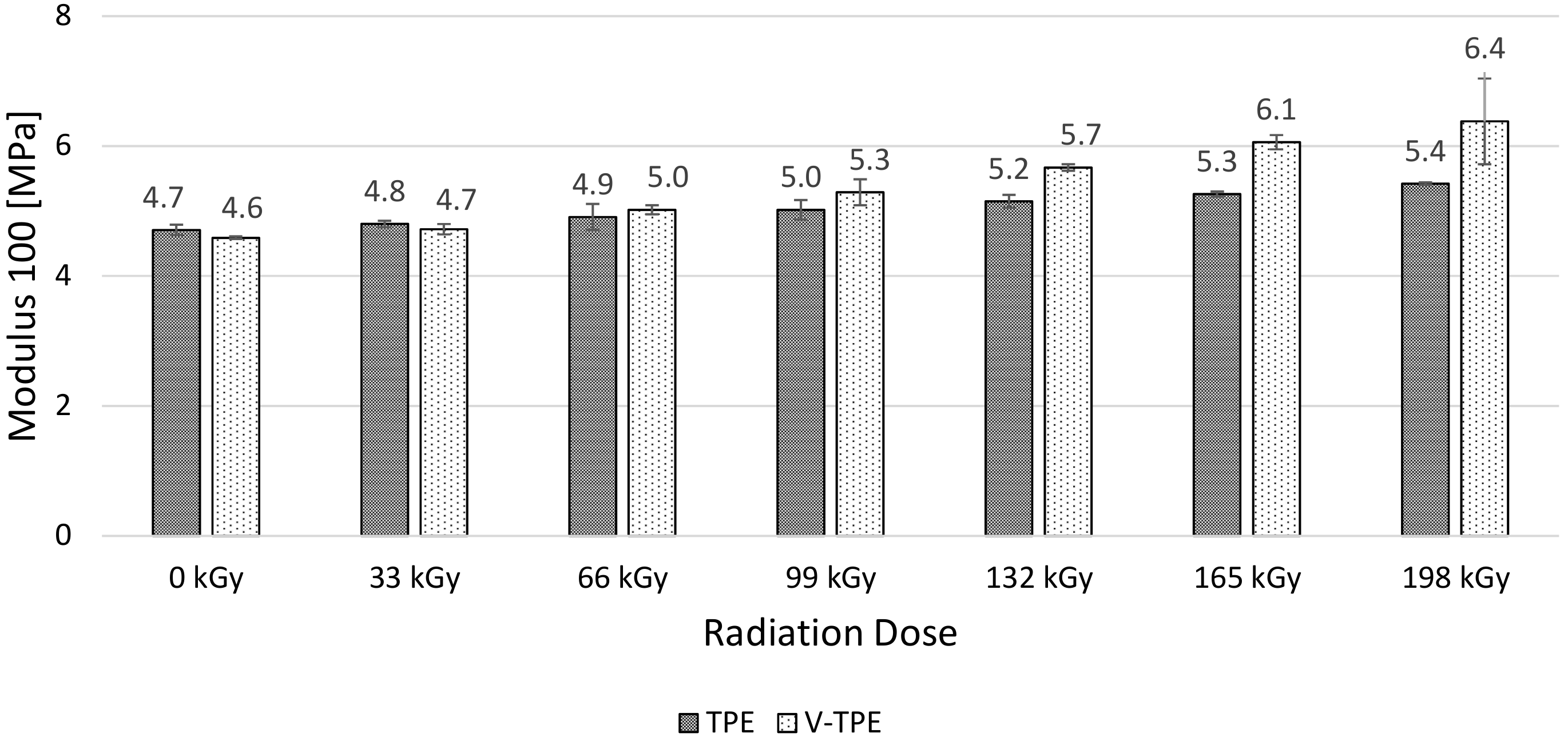
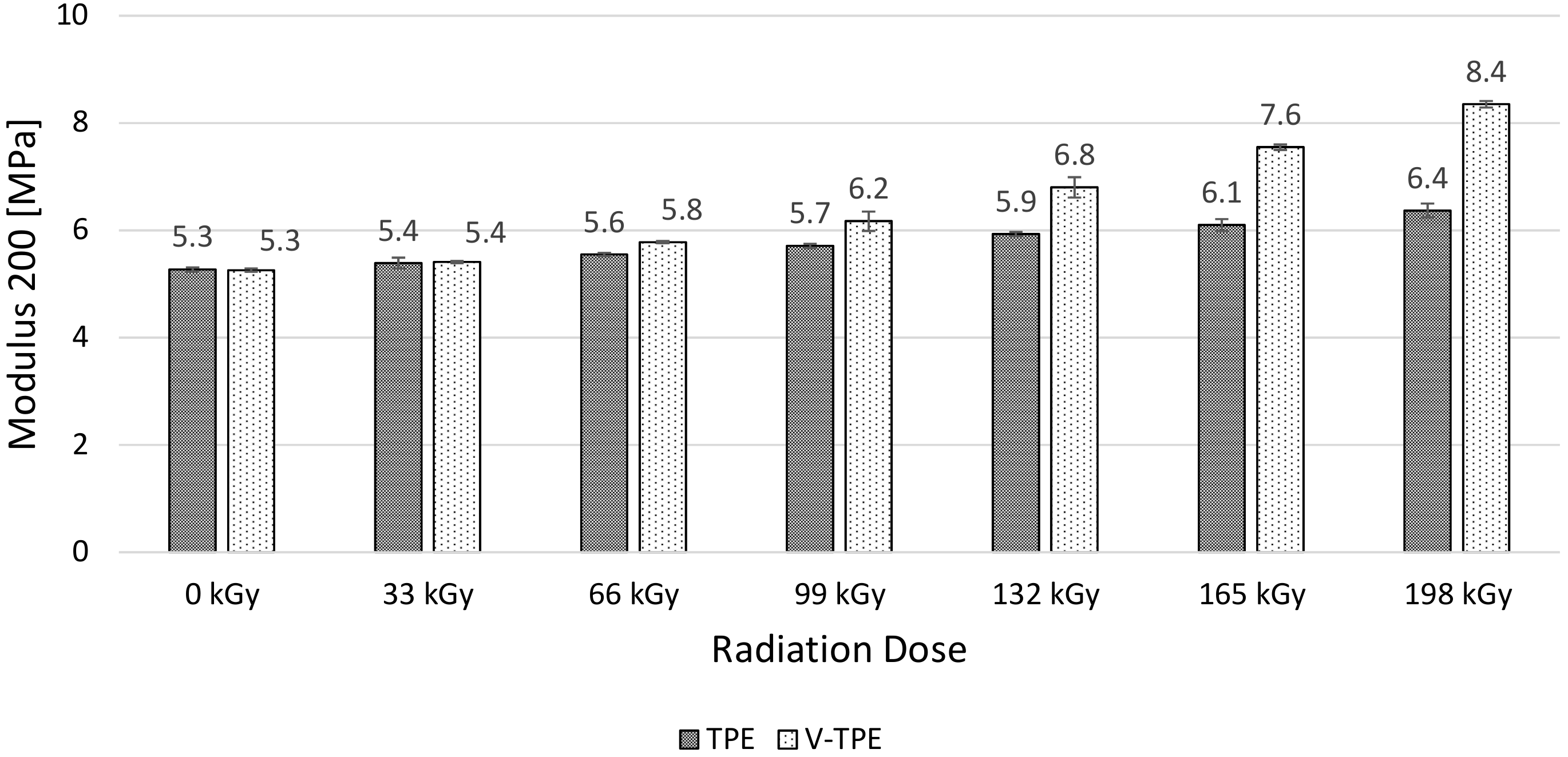
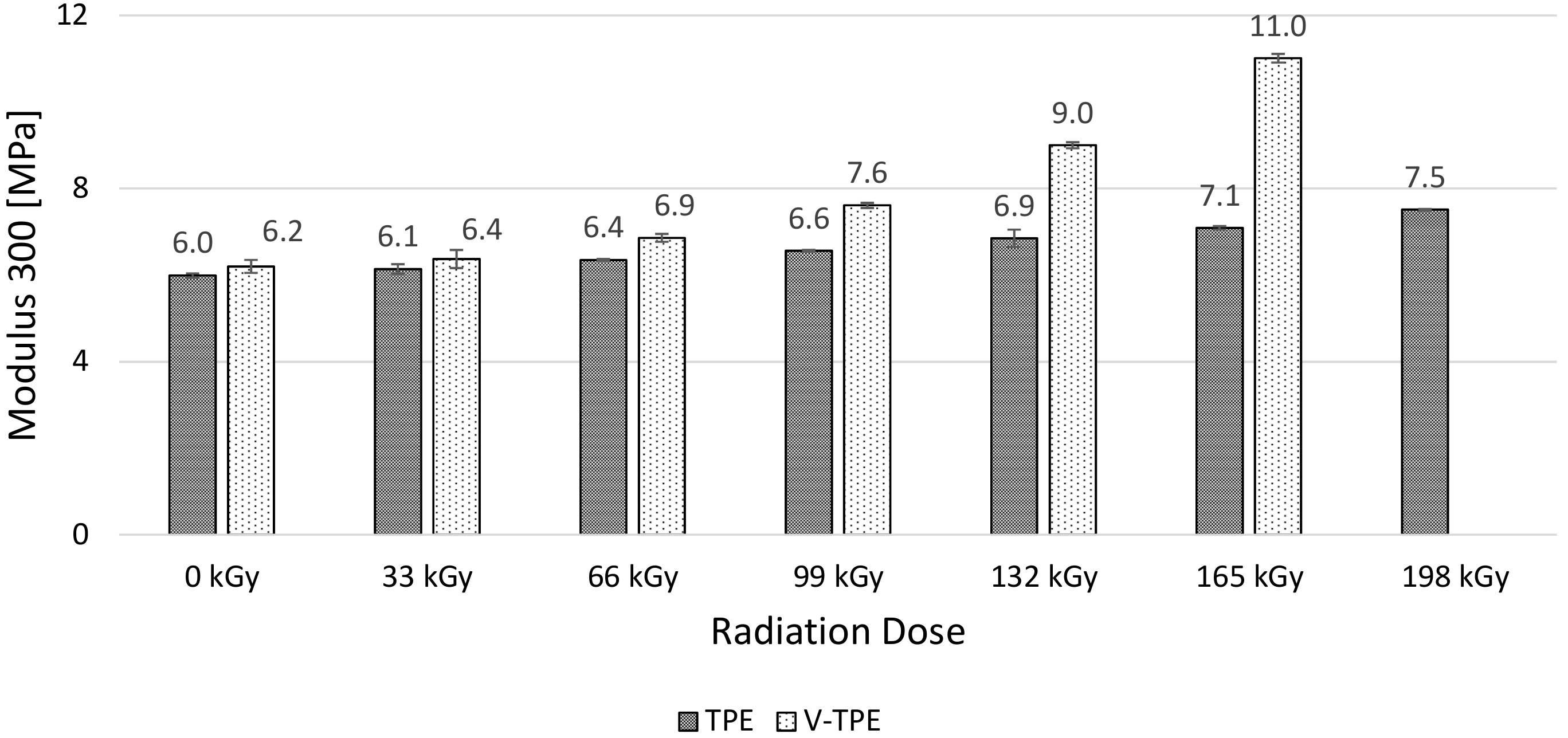
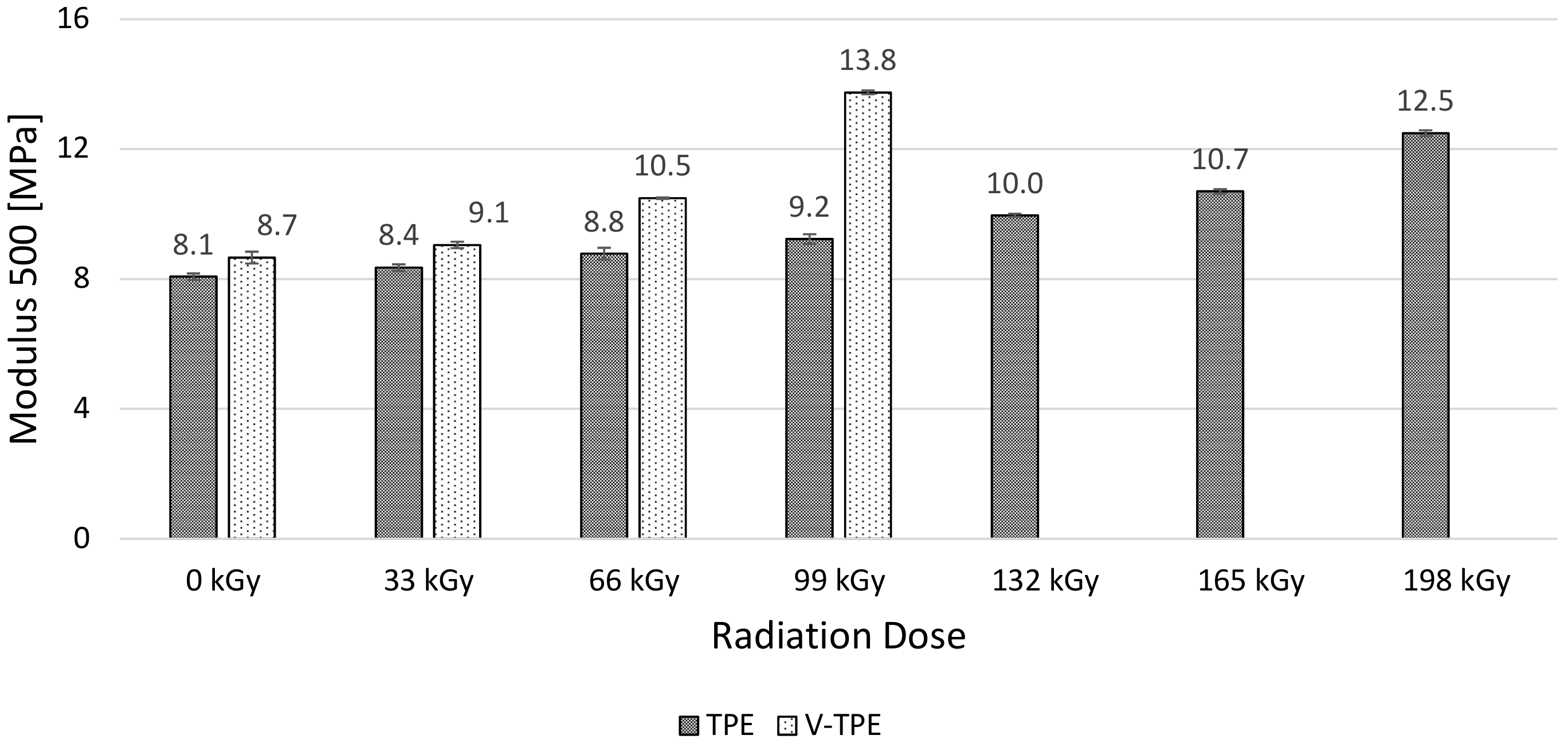
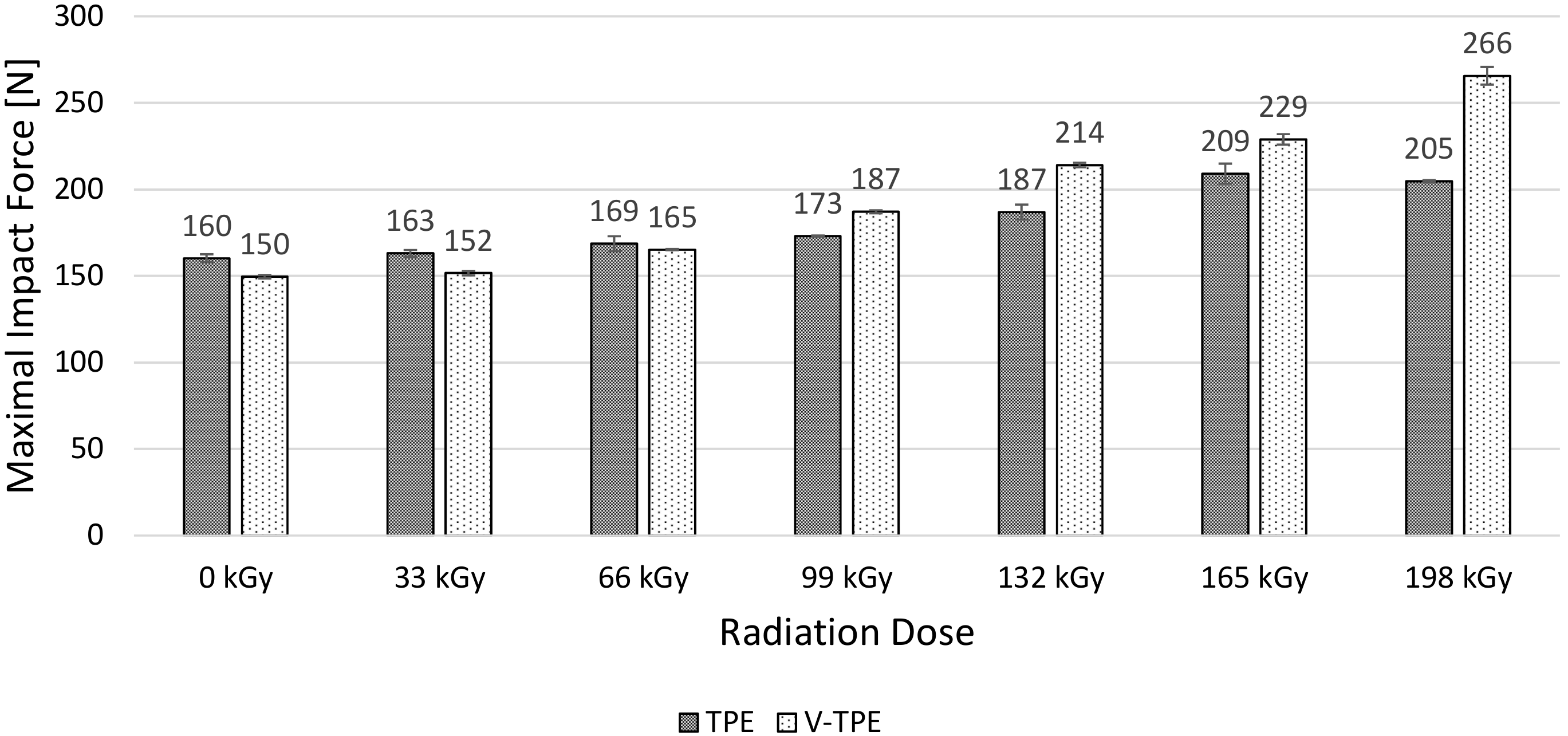

| Properties | Test method | Unit | TPE value | V-TPE value |
|---|---|---|---|---|
| Hardness | ISO 868 | 84 | 87 | |
| Hardness | ISO 868 | 27 | - | |
| Density | ISO 1183 | g cm | 1.1 | 1.1 |
| Tensile strength | ISO 527-1/-2 | MPa | 16 | 17.8 |
| Elongation at break | ISO 527-1/-2 | % | 800 | 500 |
| Melting point | ISO 11357-1/-3 | C | 165 | 165 |
| Arburg Allrounder 170U 150-30 | ||
|---|---|---|
| Injection Velocity | 50 | mm s |
| Injection Pressure | 45 | MPa |
| Cooling Time | 15 | s |
| Mould Temperature | 30 | C |
| Holding Pressure | 40 | MPa |
| Temperature of Plasticizing Unit Zones | ||
| Temperature under the Hopper | 30 | C |
| Temperature Zone 1 | 170 | C |
| Temperature Zone 2 | 185 | C |
| Temperature Zone 3 | 200 | C |
| Temperature Zone 4 | 210 | C |
| Required irradiation dose (kGy) | Real surface irradiation dose (kGy) |
|---|---|
| 0 | 0.0 |
| 33 | 38.7 |
| 66 | 77.4 |
| 99 | 116.1 |
| 132 | 154.8 |
| 165 | 193.5 |
| 198 | 232.2 |
© 2018 by the authors. Licensee MDPI, Basel, Switzerland. This article is an open access article distributed under the terms and conditions of the Creative Commons Attribution (CC BY) license (http://creativecommons.org/licenses/by/4.0/).
Share and Cite
Manas, D.; Mizera, A.; Manas, M.; Ovsik, M.; Hylova, L.; Sehnalek, S.; Stoklasek, P. Mechanical Properties Changes of Irradiated Thermoplastic Elastomer. Polymers 2018, 10, 87. https://doi.org/10.3390/polym10010087
Manas D, Mizera A, Manas M, Ovsik M, Hylova L, Sehnalek S, Stoklasek P. Mechanical Properties Changes of Irradiated Thermoplastic Elastomer. Polymers. 2018; 10(1):87. https://doi.org/10.3390/polym10010087
Chicago/Turabian StyleManas, David, Ales Mizera, Miroslav Manas, Martin Ovsik, Lenka Hylova, Stanislav Sehnalek, and Pavel Stoklasek. 2018. "Mechanical Properties Changes of Irradiated Thermoplastic Elastomer" Polymers 10, no. 1: 87. https://doi.org/10.3390/polym10010087
APA StyleManas, D., Mizera, A., Manas, M., Ovsik, M., Hylova, L., Sehnalek, S., & Stoklasek, P. (2018). Mechanical Properties Changes of Irradiated Thermoplastic Elastomer. Polymers, 10(1), 87. https://doi.org/10.3390/polym10010087







